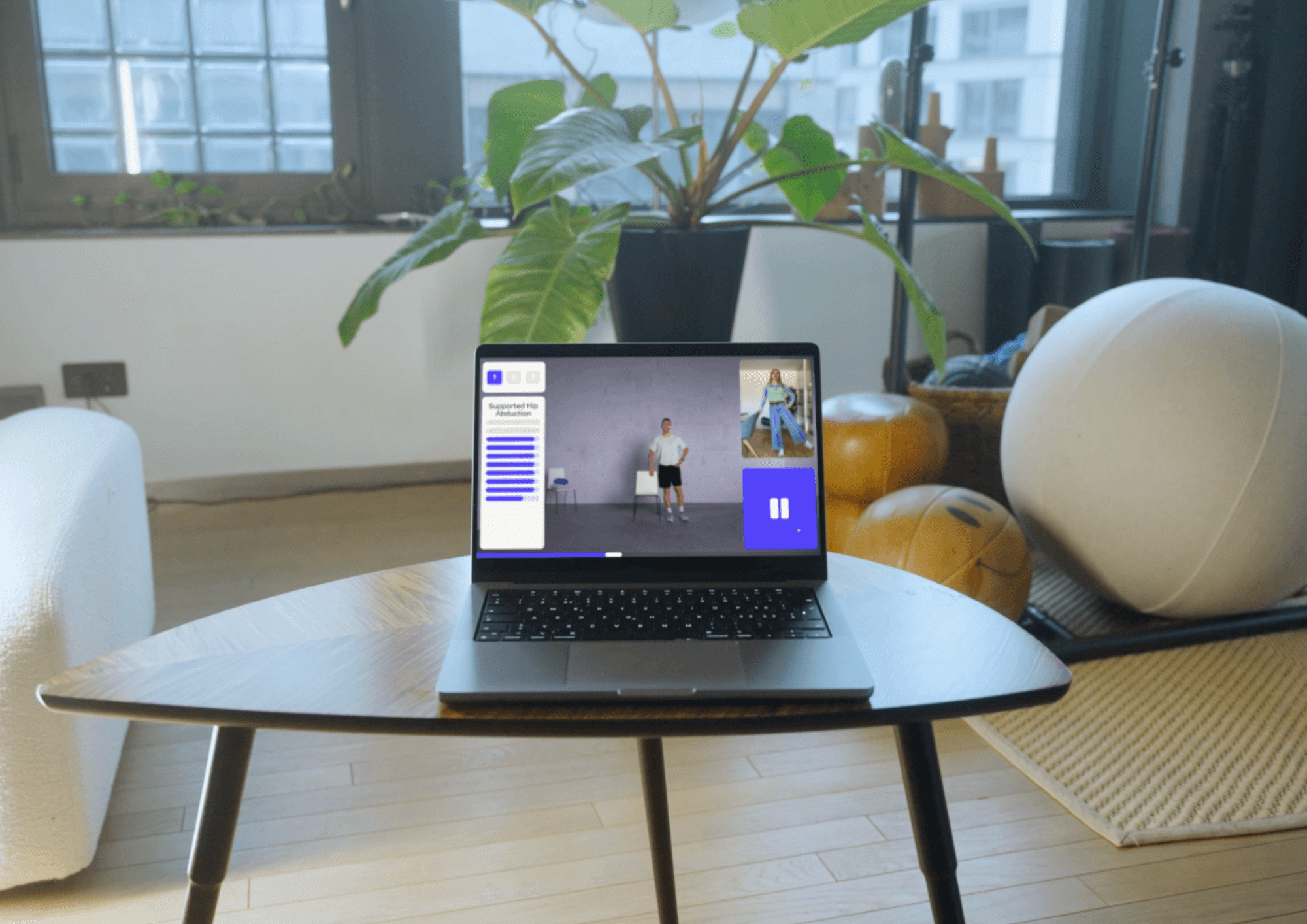Frequently asked questions: This is what physiotherapists want to know about Akina
Akina is an innovative tool for optimizing healthcare in the field of physiotherapy. Find out everything you need to know about Akina as a physiotherapist in this collection of frequently asked questions!

We are fully aware that our software raises a lot of questions among physiotherapists. And rightly so: the general functionality, technical details and diverse possibilities of our innovative product are still new territory for many. Do you also have some uncertainties or questions about Akina? Then you've come to the right place: below you will find a collection of all the questions we are regularly asked by physiotherapists. Including answers, of course ;-)
Questions about the Akina therapy plans
Our software offers various therapy plans for different indications, which you can assign to your patients accordingly. These therapy plans contain a predefined set of active exercises, educational content relevant to the respective indication and restorative mindfulness meditations.
How was the therapy plan developed?
Our therapy plan development is an extensive process. Where possible, we use existing treatment plans from renowned clinics, which we adapt for our software and combine with internal reviews. Once the content of the therapy plan has been defined, a database of exercises is created. Of course, our software also includes a database of movement corrections - these are later incorporated individually into the user's training session in order to optimize the training process. Once these two databases have been created, a feedback round is held with doctors and physiotherapists to evaluate the practical implementation of our therapy plans. As soon as the experts have given their OK, we move on to the technical implementation and detailed preparation of all the associated information.
Can I add my own exercises to the therapy plan or remove exercises?
Our therapy plans are based on thorough research and have been developed together with experienced physiotherapists and doctors. The exercises included are based on scientific findings and have been proven to work for the majority of patients. The efficacy of our therapy plans - and thus the reimbursement by health insurance - can only be guaranteed if a consistent set of exercises is always performed. It is therefore not possible to add your own exercises to the therapy plan or to delete exercises from the plan.
What is possible and recommended, however, is to adjust the level of difficulty, intensity and repetitions of the exercises to take account of the patient's needs or limits.
How can I adjust the level of difficulty in the therapy plan?
Each exercise has a maximum of three different levels of difficulty. The levels of difficulty of the exercise overlap greatly in the muscles and movement patterns used. However, they increase in exhaustion and complexity.
All users start with difficulty level 1, which is the easiest of a maximum of three difficulty levels. Depending on pain sensation, perception of exercise difficulty and movement quality, the level of difficulty can be increased from session to session until the most difficult level of exercise is reached. This adjustment of the level of difficulty does not happen within a single session, but between two individual sessions.
Akina is always the default setting and remains consistent with difficulty levels and therapy program. However, the physiotherapist always has the option of overriding Akina by selecting a different level of difficulty. They cannot add new exercise variants themselves.

Questions about feedback via Akina
Akina Portal is a remote therapeutic monitoring tool that provides you with an insight into the training your patients are doing at home with Akina. You can see an overview of important criteria such as the number of repetitions, movement quality and subjective information such as perceived pain or difficulty during training. Your patients can also use Akina to leave a comment or ask a question about the training. You can respond via text, audio or video message.
What is remote therapeutic monitoring (RTM)?
Remote therapeutic monitoring (RTM) is a new approach to seamless, effective and cost-efficient patient care. It uses technology to connect patients and professionals between regular therapy appointments. Such a software solution can monitor the function of the musculoskeletal system and increase the efficiency of training.
RTM should not be confused with RPM (Remote Patient Monitoring), which monitors physiological data such as blood sugar or heart rate. Remote therapeutic monitoring (RTM) focuses on monitoring movement, subjective data such as pain, and the effect of the prescribed therapy.
Can I only give summarized feedback for the entire training session or also exercise-specific feedback?
You can give one feedback per session - you decide whether you want to refer to the entire training session or an individual exercise! If you see in the evaluation that your patient had particular difficulty with a specific exercise or asks you a question about a specific exercise, it would of course make sense to address this in your feedback.
Are the assessment criteria "exercise completion" and "movement quality" completely independent of each other?
Yes. Exercise completion is only about whether your patient has completed the exercise with all repetitions or whether they have aborted or skipped exercises. Movement quality is about how the patient performed the exercise and whether this execution was effective within the framework of the training plan.
At what point should I give feedback?
That's up to you. Of course, it makes sense for your patient's ongoing training if you provide feedback as soon as possible so that they can integrate your suggestions for improvement into their next training session. However, the patient is not dependent on your feedback to start the next session with Akina.
Carolina from Akina explains step by step how to get started with Akina Portal as a physiotherapist.
Questions about Akina Care
Our software consists of two parts: Akina Care and Akina Portal. Care is the part of the software that is visible to patients. It contains therapy plans and instructions for therapeutic training at home. Portal, on the other hand, is the part that acts as a remote therapeutic monitoring tool for PTs. This is where you receive evaluations of your patients' training sessions and can provide them with feedback.
Is Akina safe for patients?
If you recommend exercise therapy to a patient, you can confidently prescribe exercise therapy with Akina. In these cases, training with Akina serves as an additional risk reduction measure, as there is constant feedback during the exercises at home. We are aware that exercise therapy is not suitable for all patients at all stages of their recovery, which is why a doctor's prescription is required to use the software.
Can patients ask questions about specific exercises or just leave a general comment?
Patients can only send you one message per training session. In it, they can make a comment or ask a question. This question can be about a specific exercise or about general topics. We have deliberately decided against a chat function so that feedback remains focused and communication efficient.
Does the pain level reported by patients indicate general pain or does it relate to a specific exercise?
As a rule, this refers to the general pain level felt by the patient over the entire training session. However, if the patient felt particularly severe pain during a specific exercise, they can let you know by mentioning this in their comment.
Is there a BMI limit for using Akina?
There is currently no set BMI restriction for the use of Akina. It is in line with the guidelines for recommending exercise therapy for all patients. If you would prescribe exercise therapy to a certain patient, you can also recommend them Akina. We recognize that exercise therapy is not appropriate for all patients at every stage of their recovery, which is why we emphasize the importance of physician prescription for such decisions.
What is the educational content in the software? How can I know what is being said?
The educational content that is played during the training breaks contains thoroughly researched input from specialists relevant to the training plan, in order to support your patients in leading a healthy lifestyle. Going forward, all knowledge content will be made available to physiotherapists in a database in text format and on a YouTube playlist in video format.
Can patients contact me at any time?
Don't worry, Akina is not a messenger or video call service. Your patients do have the opportunity to leave a question or comment about the session, but you decide when and how you respond. Akina offers the physiotherapist an opportunity to accompany the training at home remotely and asynchronously and make it more effective through targeted feedback. However, the timing and extent of the feedback is entirely up to the physiotherapist.

Questions about costs and cost-effectiveness
Software like Akina will bring a breath of fresh air to the Swiss healthcare system and can encourage one or two changes in the physiotherapy profession.
How much does Akina cost for physiotherapists?
Akina is free of charge for patients and physiotherapists and we are actively working on making it a tariff-based service that is billed via health insurance companies. This is already working in other countries: in the US, up to 20% of physiotherapists are already working 8 hours a week with similar software tools for remote therapeutic monitoring.
Can I work remotely with Akina?
Yes, Akina's new approach to remote therapeutic monitoring allows you to work flexibly and remotely from your home office.
Do I need to worry that software products like Akina will be my competition in the future?
We are convinced that this will not be the case. At Akina, we see ourselves as a partner and supporter for physiotherapists. Our goal is to extend your reach beyond your practice and connect you with your patients wherever they are. If you ask us, AI software like Akina will never replace human physiotherapists. But forward-thinking physiotherapists who use digital tools will likely replace those who don't.
Other questions about Akina
Will there be a mobile version for cell phones?
Yes, there will be a mobile version for physiotherapists in the future. However, we believe that it is impractical for patients due to the difficult positioning of the device and the size of the screen.
What technical requirements are needed to use Akina Portal?
You and your patients can use Akina from any smart device with a webcam. Whether on Apple or Windows, via desktop browser or in our mobile app: Akina is there for you.
What about data security?
At Akina, data protection is our top priority. Unlike most comparable services, Akina does not collect any video data from patients. Our AI converts the raw video into joint coordinates directly on the patient's device. And the coordinate data is stored securely in Zurich together with the patient profiles in accordance with the strict Swiss Data Protection Act revDSG.

Do you have any further questions?
We will be happy to answer your questions personally. Contact us by email at contact@akina.health to find out more about how Akina works and how your practice or clinic can benefit from our platform. Perhaps you are not too far from our headquarters in Zurich and would like to meet us in person? In patient care as in business relationships, we always strive to combine the best of digital and personal interaction. We look forward to meeting you!
